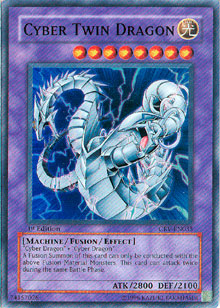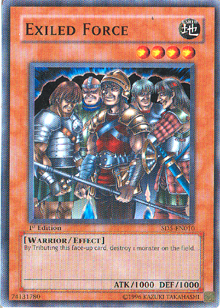
Cyber-Stein has been an influential card ever since Cybernetic Revolution was released. Cyber Twin Dragon and Cyber End Dragon are incredible Fusion monsters, but it can be very hard to Fusion summon them properly. As such, Yu-Gi-Oh! TCG players naturally turned to alternate ways to harness their power. Cyber-Stein was the immediate solution. 5000 life points is a hefty payment, but if your Fusion cards are able to take an opponent out on the very turn you pay that life, it no longer becomes a liability.
 It didn't take long for people to put together the idea that Zaborg the Thunder Monarch + Cyber Twin Dragon = 8000 life points of damage. The same goes for the combination of Cyber End Dragon and Limiter Removal, which puts 8000 ATK on the field in a single monster. The drawback to this strategy was very small. Zaborg the Thunder Monarch was already a popular card, and Limiter Removal worked very well with other cards in the deck, like Dekoichi the Battlechanted Locomotive, Cyber Dragon, or Return from the Different Dimension. Last Will had also been conveniently errata'd around the same time, and was now a very useful card to combo with Spirit Reaper or Sangan, as well as providing the OTK potential with Cyber-Stein if you have more than 5000 life points.
It didn't take long for people to put together the idea that Zaborg the Thunder Monarch + Cyber Twin Dragon = 8000 life points of damage. The same goes for the combination of Cyber End Dragon and Limiter Removal, which puts 8000 ATK on the field in a single monster. The drawback to this strategy was very small. Zaborg the Thunder Monarch was already a popular card, and Limiter Removal worked very well with other cards in the deck, like Dekoichi the Battlechanted Locomotive, Cyber Dragon, or Return from the Different Dimension. Last Will had also been conveniently errata'd around the same time, and was now a very useful card to combo with Spirit Reaper or Sangan, as well as providing the OTK potential with Cyber-Stein if you have more than 5000 life points.
Cyber-Stein itself is quite versatile. It's obviously most feared and praised for its ability to end games in a flash. When combined with the right cards, Cyber-Stein can end games in ways that make it next to impossible to stop. The scariest thing about this? The combo cards are all very good on their own or in other situations. Heavy Storm, Cyber Dragon, Zaborg the Thunder Monarch, and Last Will appear in a great many decks because they're amazing cards in many different situations. However, if you can put them all together, and if you have over 5000 life points with Cyber-Stein in your deck (and an opponent with only one monster on his or her side of the field), you've probably won the game.
As usual, the metagame reflected the abuse of one specific card. Both players will often attempt to knock the opponent under 5000 life points, even if it means being somewhat reckless. Then Cyber-Stein cannot use its effect, and punishes a greedy player for playing it when drawn after it's usefulness window is closed. So what do you do with Stein now? Many players have simply stopped playing it. Many more now play only one copy, grateful for the amount of times it pulls them out of a seemingly-hopeless situation. One player took the idea in a completely different direction, however, and was rewarded with a Top 8 spot at the most recent Shonen Jump Championship in Boston. That player is Robert Ackerman, and this is the revolutionary deck he took to Top 8:
Monsters: 20
2 Zaborg the Thunder Monarch
1 Don Zaloog
3 Cyber Dragon
1 D. D. Assailant
1 Mystic Tomato
2 Cyber-Stein
2 Exiled Force
1 D. D.Warrior Lady
2 Gravekeeper’s Spy
1 Sangan
1 Spirit Reaper
1 Breaker the Magical Warrior
1 Dekoichi the Battlechanted Locomotive
1 Magician of Faith
Spells: 15
1 Last Will
3 Smashing Ground
1 Graceful Charity
2 Reinforcement of the Army
1 Nobleman of Crossout
1 Premature Burial
1 Heavy Storm
1 Enemy Controller
1 Mystical Space Typhoon
1 Confiscation
1 Pot of Avarice
1 Book of Moon
Traps: 5
2 Royal Decree
1 Mirror Force
1 Torrential Tribute
1 Ring of Destruction
 Ackerman's deck was one of the best choices for an unpredictable metagame. It's very aggressive, which is perfect for a period when players are uncertain about deckbuilding. An uncertain group of players tends to lead to slower, lagging decks. They aren't completely refined, and tend to play just a little slower to keep a tight control on the game. The weaknesses are still apparent, and aggressive players can take advantage of any slip-ups.
Ackerman's deck was one of the best choices for an unpredictable metagame. It's very aggressive, which is perfect for a period when players are uncertain about deckbuilding. An uncertain group of players tends to lead to slower, lagging decks. They aren't completely refined, and tend to play just a little slower to keep a tight control on the game. The weaknesses are still apparent, and aggressive players can take advantage of any slip-ups.
Ackerman's deck is definitely aimed at being aggressive. We can see this partly in the trap line-up. Royal Decree usually means a fast-paced game strategy. Backed up by three copies of Smashing Ground, Ackerman is clearly planning on taking out quite a bit of his opponent's life points very quickly. Royal Decree paves a path for his monsters around defensive trap cards, while Smashing Ground ensures any and all monsters will be out of his way. Together the two cards create a tempo engine that make game-shots much more plausible.
The perfect Stein shot doesn't come along all the time. Often, Cyber-Stein is used by a desperate player in an attempt to regain control of a game using The Last Warrior from Another Planet or Gatling Dragon. Just as often, the card is discarded or destroyed without using its effect. On rare occasions, it's used for an OTK. That's generally how Stein is played in most decks.
However, Ackerman can use Cyber-Stein as a "nail-in-the-coffin" type of card, bringing out Cyber End Dragon or Blue-Eyes Ultimate Dragon to push through any final damage. This is simply because of the tempo the deck can generate by packing Royal Decree and Smashing Ground in such numbers. The remaining traps are kept to a minimum to work around Royal Decree. Mirror Force, Torrential Tribute, and Ring of Destruction are destruction cards in their own right, and were the only traps Ackerman deemed essential enough to play despite the risk of having Royal Decree active.
Turning now to the monster line-up, you can see how the goals of keeping the game fast-paced and maintaining constant tempo-based pressure are applied. Gravekeeper's Spy is excellent for maintaining field presence. Its high DEF and self-replacing ability usually allow it to add another copy of itself to the field. This extra special summon gives you a greater field presence than your opponent usually expects. Gravekeeper's Spy can then either act as the defender of your own life points, or force through damage for over a quarter of your opponent's life points.
 Exiled Force acts in precisely the opposite way. It also contributes to a faster tempo and greater field presence by removing monsters from the opponent's side of the field. This would usually let Ackerman get in an extra shot with Cyber Dragon (protected by Royal Decree) and/or one of his other, smaller monsters. These smaller direct attacks add up, however, when Ackerman wants to push through the final damage with Cyber-Stein.
Exiled Force acts in precisely the opposite way. It also contributes to a faster tempo and greater field presence by removing monsters from the opponent's side of the field. This would usually let Ackerman get in an extra shot with Cyber Dragon (protected by Royal Decree) and/or one of his other, smaller monsters. These smaller direct attacks add up, however, when Ackerman wants to push through the final damage with Cyber-Stein.
Zaborg the Thunder Monarch is especially useful in this deck. When direct attacks are quite common, Zaborg can be the iron fist that punches through the final damage in a duel. A field-clearing effect and 2400 ATK can end games before the opponent has a chance to mount a comeback. Zaborg contributes to the effect of Cyber-Stein more than any other monster, and when combined with Last Will, makes one extremely lethal combo.
The deck's synergies don't end there though: the Warrior toolbox provides the same type of tempo-based control. The D. D. Assailant/D. D. Warrior Lady team provides excellent field equalization. Forcing both players into a simplified field situation is an excellent strategy when you've got Cyber-Stein, so long as you can stay above 5000 life points. The entire Warrior department of Ackerman's deck pushes this strategy, which is why he's included two copies of Reinforcement of the Army.
The rest of the deck shows the same purpose behind every card. Mystic Tomato maintains a positive field presence, Dekoichi the Battlechanted Locomotive is excellent at pushing through small amounts of anal damage, and Spirit Reaper strips resources away from the opponent quickly before being destroyed. The remaining monsters and spells follow the same simplification philosophy or are simply unique and powerful enough to warrant inclusion.
Robert Ackerman has applied Cyber-Stein in a way no other player has done before. By using it as a game-ender, as well as a potential OTK card, he effectively negates the possibility of Stein becoming a poor draw. Taking a deadly set of cards and turning them into a focused tool for victory is one of the things Yu-Gi-Oh! TCG deckbuilding is all about, and Ackerman was rewarded for this piece with a Top 8 finish.